Highlights
What are the main findings?
- The study presents the first comprehensive and high spatiotemporal resolution 3D displacement field of the Puruogangri Ice Field (PIF) from 2017 to 2024, revealing significant seasonal velocity variations and surge events on three glaciers.
- The results show that summer velocities are approximately six times the winter velocities on average, and peak displacements during surges exceed 110 m in 12 days.
What is the implication of the main finding?
- The findings enhance our understanding of glacier dynamics in the central Tibetan Plateau and highlight the potential of using SAR imaging geodesy to monitor glacial hazards in High Mountain Asia.
- The study suggests that damaged subglacial drainage systems may trigger glacier surges, indicating that the mechanism of glacier surging in the region is hydrological control.
Abstract
The Puruogangri Ice Field (PIF) in the central Tibetan Plateau, known as the world’s Third Pole, is the largest modern ice field in the Tibetan Plateau and a crucial indicator of climate change. Although it was thought to be quiet, recent studies identified possible surging behaviors. But comprehensive velocity fields remain largely unknown. Here we present the first comprehensive and high spatiotemporal resolution 3D displacement field of the PIF from 2017 to 2024 using synthetic aperture radar (SAR) imaging geodesy. Using time-series InSAR and time-series pixel offset tracking and integrating ascending and descending Sentinel-1 SAR images, we invert the time-series 3D displacement over eight years. Our results reveal significant seasonal variations and three surging glaciers, with peak displacements exceeding 110 m in 12 days. Combined with ERA5 reanalysis and SAR backscatter coefficients analysis, we demonstrate that these surges are hydrologically controlled, likely initiated by damaged subglacial drainage systems. This study enhances our understanding of glacier dynamics in the central Tibetan Plateau and highlights the potential of using SAR imaging geodesy to monitor glacial hazards in High Mountain Asia.
1. Introduction
As global warming accelerates, glacier surges, namely, a sudden increase in glacier velocity, are becoming more prominent [1,2,3,4]. Although surge-type glaciers account for only ~1% of glaciers worldwide, they are often the primary cause of glacial lake outburst floods (GLOFs) and debris flows [5,6]. With the ongoing global warming, the frequency and intensity of glacier surges are likely to increase. Investigating the surge phenomenon is of great scientific and social importance for understanding the glacier dynamics, mitigating glacier hazards, and developing related response strategies.
The surge process is represented by an abrupt rise in surface velocities and, therefore, can be captured by monitoring glacier velocity fields [7,8]. Methods include pole measurement, GNSS (Global Navigation Satellite System), and optical/radar imaging geodesy. Pole measurements and GNSS can provide pointwise, accurate measurements about glacier movement but are hard to conduct in harsh mountain environments. Cross-correlating optical images allows for deriving horizontal velocity fields; however, cloud coverage often hinders the continuity of measurements [9,10,11]. Radar imaging geodesy, i.e., Synthetic Aperture Radar Interferometry (InSAR) and pixel offset tracking, can provide high-resolution velocity fields for studying glacier dynamics. Based on phase information, InSAR is accurate but is limited by decorrelation due to large displacement gradients, glacier melting, and ice/snow redistribution [12,13,14,15]. Cross-correlating radar amplitude images, i.e., pixel offset tracking, has lower accuracy at the 1/10 to 1/30 pixel-spacing level but is robust in measuring large-gradient displacement and thus is often applied to map glacier flows [16,17,18,19].
The Tibetan Plateau, hosting ~80,000 glaciers, plays a vital role in the cryosphere (Figure 1a). It serves as the “water tower of Asia” by storing nearly 8 trillion m3 of freshwater as ice, making it a crucial water resource for nearly 2 billion people [20]. Studies on the Tibetan Plateau indicate that significant mass loss and retreat have occurred in the Himalayas [21,22,23] and the southeastern plateau, along with documented glacier surges [2,24,25,26,27]. In contrast, anomalies of mass accumulation in the Karakoram region are observed [28,29], highlighting the complexity of glacier dynamics in this region [30].
Puruogangri Ice Field (PIF) is the largest modern ice field situated in the middle of the Tibetan Plateau (Figure 1b) [31], spanning 33.7°N–34.05°N and 89°E–89.35°E. The PIF is a typical polar-type glacier, primarily governed by a dry, cold continental climate [32]. Strong westerly winds dominate in winter, while the Indian summer monsoon prevails in summer [33]. The first glacier inventory of China [34] indicates that the PIF covered ~422 km2 in the 1970s [32]. The ice volume is estimated as ~52 km3 [35], with observed thickness up to 350 m [36]. According to the Randolph Glacier Inventory 7.0 (RGI 7.0), the PIF can be subdivided into 91 distinct geographical units (RGI 7.0 Consortium, 2023) (Figure 1c). It comprises tens of ice cap glaciers, extending over 50 ice tongues of varying lengths into the surrounding areas [36]. The glacier elevations range from 5300 to 6482 m, while the equilibrium line altitude (ELA) varies between 5620 and 5860 m [32]. A comparison between the glacial maximum coverage during the Little Ice Age and the 1970s measurements shows a reduction of only 24.20 km2 (5.7% of its 1970s extent), equivalent to 3.66 km3 of ice volume loss [32]. While the ice field retreated to 387.87 km2 by 2021, a reduction of 34.13 km2 [37], indicating an accelerated retreat trend. For example, in the western part of PIF, the glacier A0006 retreated by 40 to 50 m, with an average rate of 1.5 to 1.9 m/year from the 1970s to the end of the 1990s (Figure 1c). Notably, this glacier retreated 4–5 m from September 1999 to October 2000 [32].
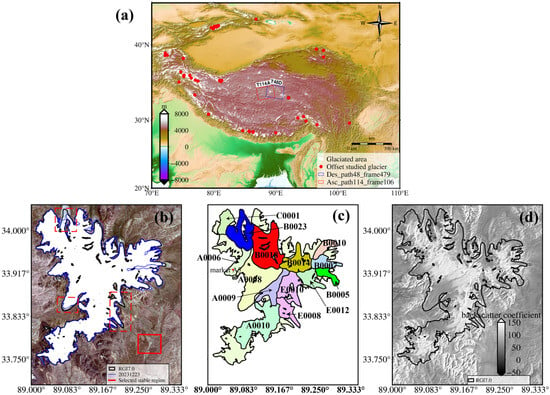
Figure 1.
Overview of the Tibetan Plateau and the Puruogangri Ice Field (PIF). (a) Topography of the Tibetan Plateau with SAR image coverage. (b) True-color optical image of the PIF from Landsat 8 acquired on 2 August 2017. The red dashed box outlines glaciers with obvious retreat. (c) Subdivision map of the PIF. Each geographical unit with an area greater than 8 km2 is represented by a unique color and labeled with a WGMS ID [38]. (d) Average backscatter-coefficient map (2017–2024) with the PIF outline from RGI 7.0 (RGI 7.0 Consortium 2023).
Mass balance studies indicate that PIF has experienced more accelerated mass loss since 2012. The mass loss rate was approximately −44 to −35 mm w.e.a−1 (millimeter water equivalent per year) from 2000 to 2012 [39,40]. According to [35,37,41], the mass loss accelerated tenfold after 2012, reaching approximately −520 to −170 mm w.e.a−1 [37,41]. By comparing RGI 7.0 boundaries (defined in 2004 and 1994) with the optical image acquired in 2023 (Figure 1b), varying degrees of withdrawal can be identified, particularly on glaciers A0008, B0023, E0008, and E0010 (Figure 1b,c).
Surface velocities of the PIF derived from different methods at different times are incomplete and exhibit a large range of variation, from several meters to tens of meters per year. For example, ref. [42] deployed eight GPS markers along the glacier A0006 in the western part of the PIF. Two observations were conducted successively from 29 September 2000 to 21 October 2009. The maximum surface velocity was 3.67 m/year, measured by GPS marker A5 near the equilibrium line (Figure 1c). Ref. [43] processed ERS-1/2 Tandem InSAR images acquired on 16 and 17 September 1998 and estimated the velocity from the one-day tandem interferogram. The average velocity across the entire PIF was 25.55 m/year, and the maximum velocity occurred in three glacier tongues in the east, reaching 43.8 m/year. While another pair of Tandem InSAR images acquired in winter (14 and 15 January 1996) shows a much smaller averaged velocity of 9.5 m/year, and the maximum velocity also occurred in the eastern part of the PIF, reaching 21.9 m/year on glacier E0012 [33]. Ref. [39] processed a pair of L-band ALOS PALSAR data acquired also in winter, on 20 January 2009 and 7 March 2009. They found that the glacier-wide mean velocity was 2.25 m/year, and the maximum velocity appearing on the B0010 glacier in the eastern part was 17 m/year, consistent with measurements from the ERS1/2 winter interferogram [33].
More interestingly, ref. [44] reported that the previously stable PIF has exhibited surging behaviors by using optical imagery. Specifically, glaciers B0018 and B0023 showed distinguished movement from October to December 2020 and from June to September 2023, respectively. The displacement occurred in their upper-middle reaches, at distances of 6.5 km and 9.9 km from the terminus, respectively. Glacier B0005 showed acceleration in the lower-middle reaches from August to December 2021. This observation is unexpected because previous studies suggest that surges are more likely to occur in the Pamir and Karakoram regions [45], marine glaciers located on the edge of the Tibetan Plateau [46], and large mountain glaciers such as those in Alaska [47,48,49,50]. For example, in the Karakoram, surge-type glaciers such as those in the Hispar and Panmah regions exhibit well-characterized cyclic surge behaviors [51,52,53]. These glaciers typically feature steep gradients [54], high ice fluxes [52], and well-defined surge cycles [51], making them ideal candidates for studying surge mechanisms. Similarly, in Alaska, the Bering Glacier has been closely monitored for decades, revealing clear patterns of surge initiation, propagation, and termination [50].
In contrast, the PIF presents a rare opportunity to investigate surge behavior in different tectonic, climatic, and glaciological settings. As a large, flat, ice-cap-type glacier located in the arid interior of the Tibetan Plateau, the PIF is characterized by lower ice velocities, a colder and drier climate, and less topographic relief. The recent observations [44] challenge the conventional understanding that surges are primarily confined to steep, maritime, or high-flux glacial systems. Investigating surge behavior in such an atypical environment not only broadens our understanding of the physical mechanisms driving glacier surges but also helps to assess the universality of existing surge models.
The previous velocity measurements, along with the surging behaviors, suggest that the surface movements of the PIF vary greatly at different locations and at different times. To the best of our knowledge, a comprehensive time series of surface velocity on the PIF is not yet available, hindering our understanding of its dynamics. Here, we present the time series of surface displacements on the PIF derived from Sentinel-1 SAR images acquired between 2017 and 2024. InSAR provides accurate measurements but only on a small portion of the PIF in winter, while pixel offset tracking reveals a more comprehensive, three-dimensional (3D) surface velocity field and time series with 0.5 km spatial resolution and 12-day temporal resolution. From the high spatial and temporal resolution surface velocity fields, we identify surges and their temporal behaviors on three glaciers of the PIF. Combined with SAR backscattering coefficient images that reflect the areas of accumulated surface water, we propose a mechanism to explain the occurrence of surges on this flat, ice-cap-type field in the middle of the Tibetan Plateau.
2. Data
2.1. Sentinel-1 SAR Data
This study utilized SAR data acquired by the Sentinel-1A/B satellites, operated by the European Space Agency (ESA). The data were accessed on 28 June 2024 through the ASF Data Search platform at https://search.asf.alaska.edu/. The Sentinel-1 mission provides C-band SAR data with a wavelength of 5.6 cm. The nominal spatial resolution of the IW (interferometric wide swath) mode is 20 m by 5 m (azimuth by range), and the revisit cycle is 6–12 days. The incidence angle range at the study site is 33–41°. The temporal interval between adjacent ascending and descending tracks is 4 days.
A total of 206 ascending (Track 114) and 216 descending (Track 48) SLC (Single Look Complex) images in the IW mode were acquired between 2017 and 2024 to conduct the interferometry and pixel offset tracking.
We also utilize the level-1 High-Resolution GRD (Ground Range Detected) products from the Sentinel-1A mission in the descending track to analyze the surface water distribution on the PIF. The averaged backscattering coefficient image of all GRD products is shown in Figure 1d.
2.2. Topographic Data
We use the latest open-source Copernicus DEM-Global and European Digital Elevation Model (COP-DEM) (30-by-30 m resolution) as the reference Digital Elevation Model (DEM) for InSAR and pixel offset tracking. The COP-DEM was acquired through the TanDEM-X mission from 2011 to 2015, which was completed in January 2015. Compared to previous DEM products, such as SRTM DEM acquired in 2000, TanDEM-X DEM represents the most recent topography of the PIF.
2.3. ERA5 Reanalysis Products
ERA5 reanalysis products are a collection of global atmospheric reanalysis data provided by the European Centre for Medium-Range Weather Forecasts (ECMWF) [55]. These products provide information about various meteorological parameters. The ERA5 reanalysis spans the period from 1979 to the present and is updated continually, with a 5-day delay. We downloaded the data from 2017 to 2024 in a gridded format with a temporal resolution of one month and a spatial resolution of 0.25° × 0.25°. We selected the temperature and precipitation reanalysis products that cover the entire PIF region, spanning from 33.7°N to 34.05°N and from 89°E to 89.3°E, to evaluate the weather conditions during the acquisition period of Sentinel-1 images.
3. Methods
The data processing includes three parts (Figure 2). First, we calculate the winter velocity of the PIF by sequential multi-temporal InSAR (MT-InSAR) and decompose the ascending and descending line-of-sight (LOS) measurements into east–west and vertical components. Second, we obtain the 3D time series velocities of the PIF by sequential multi-temporal pixel offset tracking. Third, we use the backscattering coefficient maps from the GRDH products to analyze the surface meltwater conditions of the PIF.
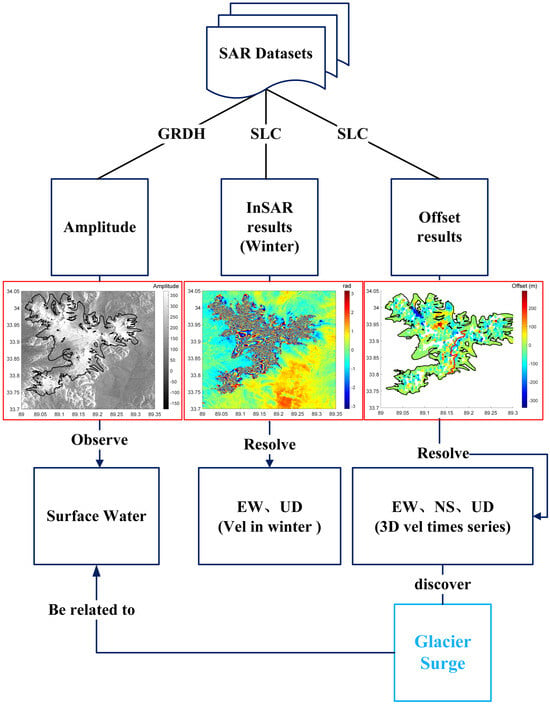
Figure 2.
Flowchart of data processing.
3.1. InSAR Processing
We use the Sentinel-1 Processor (https://sarimggeodesy.github.io/) from 28 June 2024 to 1 November 2024 to process SAR images. Due to rapid ice melting and subsequent movement, the backscattering properties of the ice change rapidly, resulting in strong decorrelation in summer (Figure 3g). Consequently, summer interferograms are not useful in providing any information (Figure 3e,f). We only use winter interferograms with 12- and 24-day temporal baselines (December, January, and February) (Figure 3a,b) to derive the surface velocities (52 ascending and 49 descending ones). We mask the areas where the coherence is below 0.3 to maintain the reliability. Thereafter, we unwrap the masked interferograms using the minimum cost flow method [56] and obtain the LOS velocities, mapping the slow-moving parts of the PIF.
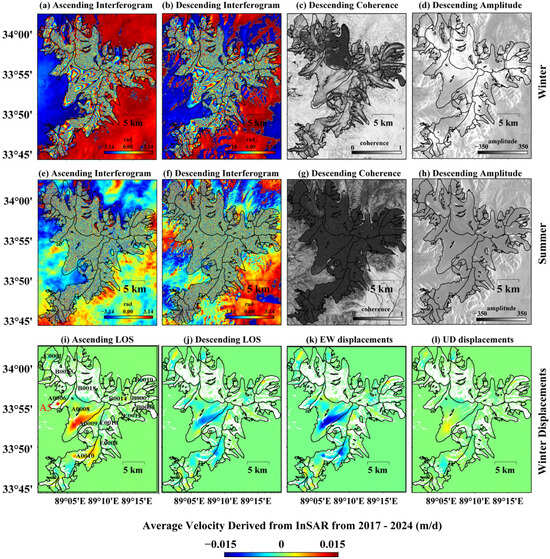
Figure 3.
Typical interferograms, coherence maps, and backscattering coefficient maps, with glacier surface velocity from InSAR. (a–d) Winter interferograms, coherence, and backscattering coefficient maps. (e–h) Summer interferograms, coherence, and backscattering coefficient maps. (i–l) Surface velocity from winter interferograms. Note that the location of GPS measurement point A5 in ref. [42] is marked in (i).
3.2. Pixel Offset Tracking
Optical/SAR pixel offset tracking is a very powerful technology widely used in fields such as remote sensing [57], glaciology [58], and earthquake source inversion [59] for measuring deformation [60]. The core of pixel offset tracking is the normalized cross-correlation (NCC). The size of the matching window is the most crucial parameter when conducting NCC [61]. Smaller windows cost less running time and can achieve higher resolution, but the results are more sensitive to noise [57]. Larger windows can encompass more surface features, producing more reliable results by smoothing out local noise, but they require more computational resources and have lower resolution [9,57,62].
To obtain the optimal window parameter, we conduct three experiments, starting with a 32-by-32-pixel window and incrementally increasing to 64-by-64 and 128-by-128 pixels. The results showed that the results of 32 and 64 pixels are much noisier than those of 128 pixels. That is because glaciers usually have weak and repetitive texture features. Within a small window, it is difficult to find enough features for matching [61,63]. Moreover, glaciers usually move faster; it is unlikely that their movement characteristics can be captured by small windows [64,65]. This causes small windows to be prone to generating more singular values.
The 128-pixel window performed better in terms of signal-to-noise ratio (SNR) and correlation values. Specifically, although windows of 32- and 64-pixels have higher resolution, outliers make it difficult to capture the true movement of the glacier. In contrast, the 128-pixel window retains the glacier flow feature while effectively reducing noise and without significantly smoothing out the peak velocity. So, we select the results from 128-by-128 windows as the most robust option. The search range is set to 8 pixels. Given Sentinel-1’s resolution of 20 m-by-5 m, 8 pixels correspond to a displacement coverage of 160 m-by-40 m per 12 days. Note that the 40 m displacement along the line-of-sight direction implies ~100 m east–west displacement. While this range may be insufficient for rapidly flowing regions like Antarctica, it is quite adequate for glaciers in the interior of the Tibetan Plateau.
3.3. The 2D and 3D Deformation Inversion
Given measurements along the LOS and azimuth directions from ascending and descending tracks, we invert for the 2D (from InSAR) or the 3D (from pixel offsets) deformation according to the availability of imaging geometries [66]:
where is the LOS deformation, are the deformations in the up–down (UD), north–south (NS), and east–west (EW) directions, respectively. is the incidence angle, and is the heading angle. Spaceborne InSAR is insensitive to the NS motions due to polar-orbiting and slant-looking geometry. Thus, we ignore the NS deformation to invert for the UD and EW deformation from ascending and descending InSAR measurements:
Pixel offset tracking provides observation in azimuth and range directions from both ascending and descending tracks, which can be used to invert for the 3D deformation from measurements in four independent directions [67]:
where and are the heading and incidence angle of the ascending track, and and are the heading and incidence angle of the descending track, respectively. The solution of Equation (4) can be obtained by the least squares method.
3.4. Time-Series Analysis
The Small Baseline Subset-InSAR (SBAS-InSAR) [68,69,70,71] and the Small Baseline Subset-Pixel Offset Tracking (SBAS-POT) methods [72] combine SAR images into several small baseline subsets. Because glaciers move rapidly, likely only the sequential images can remain correlated. We use sequential pixel offset tracking to obtain the time-series displacement. Specifically, we conduct pixel offset tracking only on image pairs with the shortest temporal baselines, namely 12 days. By referencing the first acquisition, we can obtain the time-series displacements between each two adjacent acquisitions, from which the accumulated and annual velocities can be derived.
Given the displacements derived from ascending and descending tracks, we invert for the EW/UD and EW/NS/UD velocity fields. Because ascending and descending tracks pass over the same area at different times, temporal misalignment occurred in the 3D decomposition. For static deformation such as co-seismic displacement, relatively long temporal mismatches are acceptable [73,74,75]. As for glacial motion, which involves rapid movement, the tolerance for temporal misalignment in 3D resolving is lower. For instance, the temporal mismatch between ascending and descending data is set within 2 to 3 days in the study of Yiga Glacier and South Inylchek Glacier [18,76]. But a study has mismatches of up to 150 days in the 3D inversion of Dongkemadi Glacier [19]. Their approach to addressing this mismatch is to assume that the glacier moves at a constant speed during the observing period.
We decompose the time-series 3D displacement by employing a temporal misalignment of only 4 days, which is slightly larger than ref. [18,76], but much smaller than ref. [19]. To achieve this, a strict temporal alignment strategy is implemented to match ascending–descending offset pairs for 3D inversion. Specifically, using the descending (DES) data as the reference, we determine the corresponding ascending (ASC) master image date, which is only 4 days later. Consequently, the master–slave interval for both tracks is consistently maintained at 12 days. Any descending data without a corresponding ascending match were excluded to ensure temporal consistency across the dataset. At last, a total of 198 matched ascending–descending offset pairs are obtained to invert for the 3D displacement fields.
Based on the paired ascending and descending offset data, we employ the least squares algorithm to invert for the 3D time series. First, 198 pairs of matched images are read from the pending ascending and descending offset dataset. For each ascending–descending data pair, an observation equation in the form of Equation (3) is constructed. The coefficient matrix of Equation (3) is formulated based on the deformation projection model established using the SAR observation geometry of ascending and descending tracks. For each pixel, the range and azimuth offsets from the ascending and descending tracks are combined into an observation vector . The three-dimensional deformation components are then solved using the least squares algorithm:
where , represents the east–west, north–south, and vertical deformation components, respectively. After the inversion, all results—including geographic coordinates and 3D deformation components—are stored for subsequent time-series analysis. By independently inverting each temporally matched image pair, a complete 3D deformation time series is constructed.
Because the speed of glaciers may hardly change significantly within 4 days, except for surges or ice avalanches [19], as supported by the GPS measurements of refs. [77,78], this strategy balances data utilization and temporal consistency. We acknowledge the possible bias during the alignment of ascending and descending tracks but believe such uncertainty would not change the derived glacier flow pattern.
3.5. Amplitude Map Calculation
We use the ground range detected high-resolution (GRDH) product to do the amplitude calculation. Firstly, we calculate the number of black pixels in each GRDH. The main modus is to set a threshold to segment the GRDH map. After trying different thresholds, we set the average amplitude value of all GRDH maps as a robust threshold. The pixels below the average value are regarded as dark pixels and are counted.
Secondly, we calculate the time series of the average backscattering coefficient in each of the three surge-type glaciers. We obtain the time series from 202 GRDH images from 2017 to 2024, which is helpful to reveal the change in backscattering coefficients of surge-type glaciers with time.
4. Results
4.1. Winter Velocity from InSAR
Winter (Figure 3a–d) and summer (Figure 3c–h) interferograms and coherence maps indicate that C-band, 12-day Sentinel-1 images are not applicable for the PIF in summer. For winter, only some glaciers (glaciers A0008 and A0010) of the western PIF maintain relatively high coherence (Figure 3c). The derived velocities from the ascending and descending tracks show opposite signs (Figure 3i,j), indicating that the EW motion is dominant. The EW and UD decomposition reveals that the A0008 moves westward with a velocity of 0.01 m/day (3.65 m/year) (Figure 3k). The vertical velocity clearly indicates the subsidence in the ablation zone and the uplift in the accumulation zone (Figure 3l).
The derived velocity is smaller than the results of ref. [33], who obtained the PIF velocity field using ERS images in January 1996, with a maximum value of about 0.07 m/day at the E0012 glacier (our maximum velocity is 0.01 m/day at the A0008 glacier). However, at glacier A0008, the maximum velocity derived from Sentinel-1 interferograms is almost identical to the velocity at point A5 (indicated in Figure 3i) near the equilibrium line of the PIF measured by ref. [42] using GNSS (3.67 m/year) in October 2000.
4.2. Velocity from Pixel Offset Tracking
The offset-derived velocity fields provide a more comprehensive view than InSAR. We evaluate the uncertainty of the pixel offset measurement by computing the mean standard deviations (STDs) on the PIF and the root mean square error (RMSE) within a stable region near the PIF (Figure 1b). In the remote-sensing studies of glacier dynamics, ice-free bedrock areas adjacent to glaciers—where no surface displacement is expected—are often utilized as a reference to assess the uncertainty of the derived velocity fields [63,79], providing a quantitative reference. We select an area southeast of the PIF (Figure 1b) and conduct the same 3D displacement decomposition. The RMSE in the EW, NS, and UD directions is 0.12 m/year, 2.8 m/year, and 0.38 m/year. The STD calculated on the PIF indicates the overall performance of pixel offset tracking. The STDs of range and azimuth offsets from single image pairs are about 0.56 m and 2.5 m in the whole region, respectively. The corresponding RMSE in the reference region is 0.11 m (range) and 1.4 m (azimuth). The STDs in the EW, NS, and UD directions are around 10.6 m/year, 43.8 m/year, and 14.6 m/year in the PIF region. The STD of 10.6 m/year in the EW direction is similar to the accuracy of 10 m/year of ref. [79], which is mostly derived from optical imagery. Due to the low resolution of the Sentinel-1 image in the azimuth direction, the STD of the NS direction (43.8 m/year) is much larger but lower than the excessive variance caused by glacier surges (refer to the following analysis). Note that the above STD and RMSE values are relatively small, so we use the unit “m/year” for better visualization. In the following section, we will present the results using the unit m/day.
The offset-derived velocities reveal that the main glacier flow is concentrated below the 5900 m contour line (Figure 4f), mostly below the ELAs of PIF (5620–5860 m) determined by ref. [35]. Two glaciers, B0018 and B0023, exhibit remarkably large velocities above the uncertain levels (Figure 4). From the derived 3D velocities, the maximum velocity of B0023 reaches 0.2 m/day towards the west (Figure 4e), and that of B0018 reaches 0.57 m/day towards the north (Figure 4f). Annual velocity maps reveal that the flow anomalies are not long-term phenomena but rather started in 2020 and 2023 (Figure 5), respectively. The glacier B0018 exhibits the most prominent annual velocity in 2024, reaching 1.07 m/day and 3.10 m/day in the EW and NS directions, respectively. This possible surge continued and showed no signs of stopping by June of 2024.
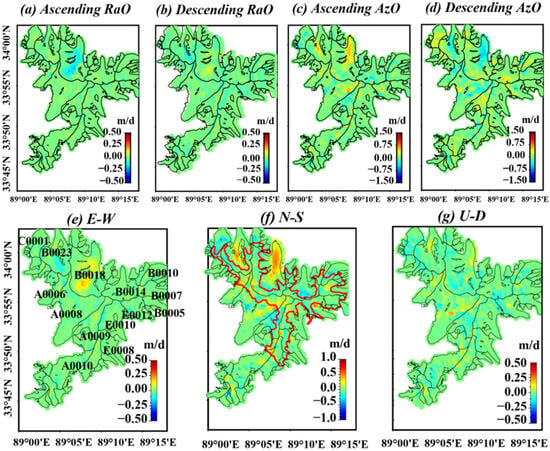
Figure 4.
Average glacier surface velocity derived from pixel offset tracking of Sentinel-1 SAR images acquired from 2017 to 2024. (a–d) Average glacier surface velocity (2017–2024) in Range and Azimuth direction of Sentinel-1 SAR ascending and descending tracks. (e–g) East-West, North-South, and Up-Down components of the glacier surface velocity, inverted from (a–d). The red contour line in (f) indicates the 5900 m elevation.
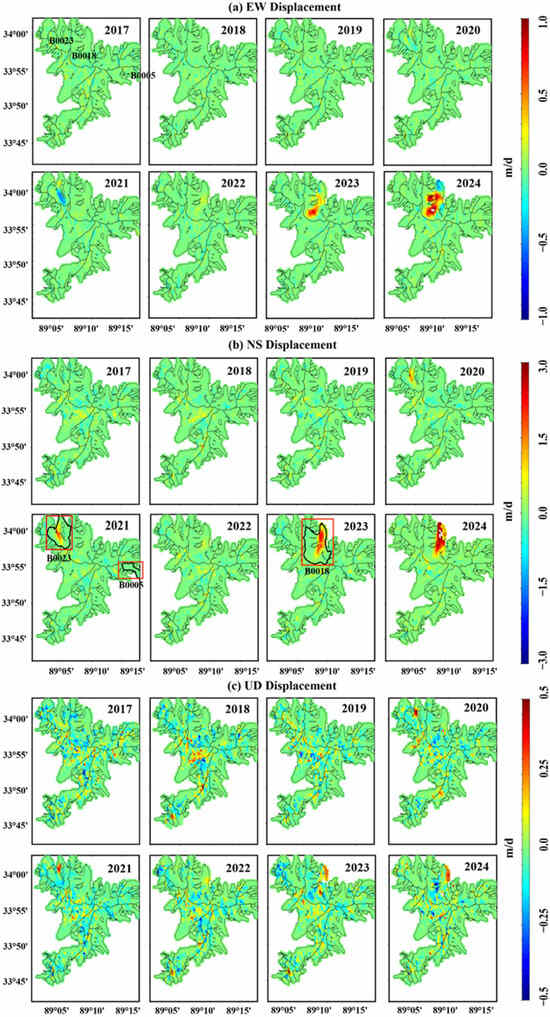
Figure 5.
Annual velocity of the PIF in EW, NS, and UD directions derived from pixel offset tracking. The red rectangles indicate the enlarged vector view shown in Figure 6.
To visualize the flow pattern, we plot the horizontal displacements as vectors at 12-day intervals during their periods of rapid movement (Figure 6). Besides the glaciers B0018 and B0023, glacier B0005 also started to flow rapidly in November 2021, consistent with the observations from optical imagery [44]. Among them, B0018 exhibits the fastest velocity, reaching 110 m in 12 days. B0023 reached 54 m in 12 days, while the movement of B0005 is the smallest, reaching 30 m in 12 days. The flow vectors align well with the geomorphological features of these glaciers (Figure 6). For glacier B0023, the ice stream exhibits bifurcation downstream, forming two distinct flow branches.
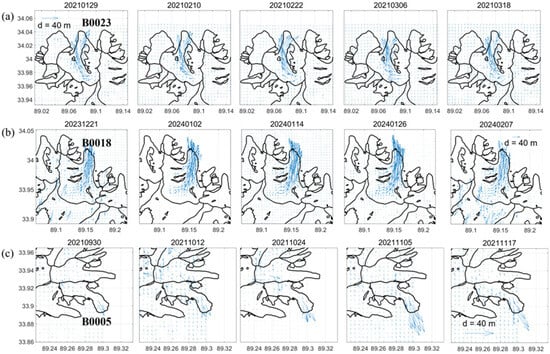
Figure 6.
12-day displacement fields as vectors for the three surged glaciers: (a) B0023, (b) B0018, and (c) B0005.
4.3. Time-Series Displacement from Offset Tracking
The annual velocity fields reveal the distribution and flow patterns of the three glaciers that exhibited anomalies. Time-series analysis of pixel offsets enables the determination of the occurrence time and temporal behavior with a 12-day resolution. We calculate the time series of displacement magnitudes averaged within each glacier for all the numbered glaciers using both ascending and descending pixel offsets. By comparing records of precipitation and temperature from the ERA5 model [55], we find a similar seasonal pattern among all the glaciers, exhibiting larger displacement magnitudes during summers characterized by higher temperatures and precipitation (Figure 7). However, as identified from the flow vectors, the three glaciers (B0005, B0018, and B0023) exhibited surges after summers in particular years.
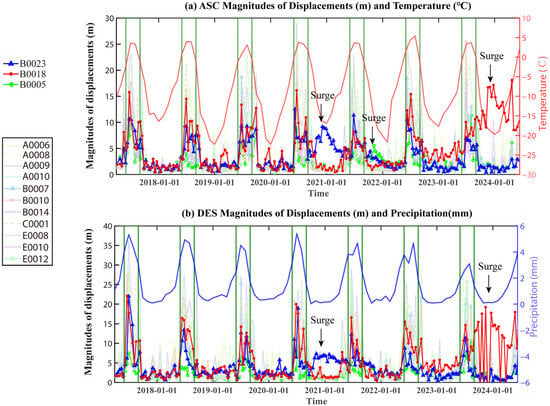
Figure 7.
Time series of 12-day displacement magnitudes averaged within each glacier. (a) Time-series 12-day displacements from the ascending track with corresponding temperatures. (b) Time-series 12-day displacements from the descending track with corresponding precipitations. The area between the green lines indicates summer periods.
We calculate the time series of 12-day displacements and cumulative displacements in the EW, NS, and UD directions of three surged glaciers (B0005, B0018, and B0023) (Figure 8a,b) with their displacement magnitudes (Figure 8c). The 3D time series calculated within the reference area is also plotted to indicate the uncertainty level. The results clearly show that their surges mostly occurred in winter. For example, the glacier B0023 began to move fast after the summer, from 7 September 2020 to 18 April 2022, overcoming two complete winters, and ended in the summer of 2022. The time-series displacements exhibit a double-peak pattern (both in winters), with the first peak being larger than the second (Figure 8). The surge of glacier B0018 began after 28 August 2022 and also exhibited a double-peak pattern in winter, with the second peak being significantly higher. This glacier continues to move rapidly till the end of our observation. The velocity and area of glacier B0005 are relatively small, and the surge lasted only one full winter, occurring from 14 September 2021 to 5 June 2022. The cumulative displacements indicate that during the surge periods, glaciers B0018 and B0023 advanced more than 200 m, which is significantly larger than the advances in other years (Figure 8). Therefore, most glaciers of the PIF experience regular seasonal changes, while glaciers B0023 and B0005 have experienced a complete surge cycle, and glacier B0018 has still been surging by the end of 2024.
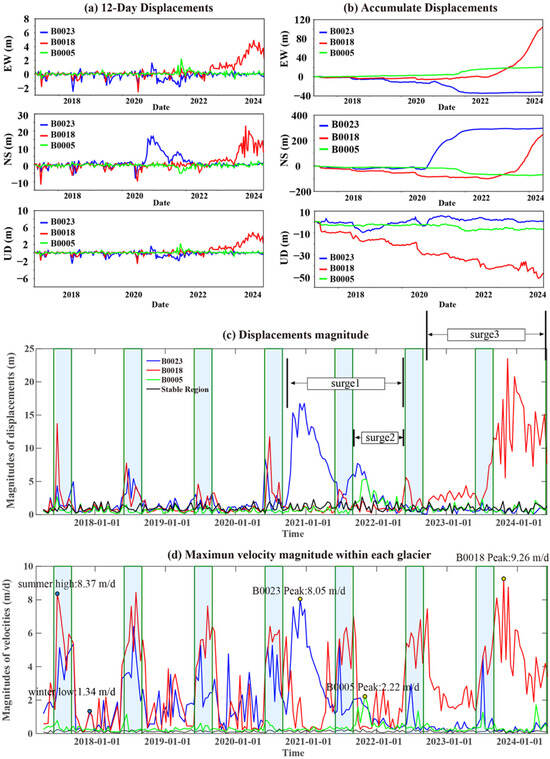
Figure 8.
Time series of 3D displacements and velocities of the three surged glaciers. (a) time series of 12-day 3D displacements. (b) Time series of accumulated displacements. (c) Time series of 12-day displacement magnitudes. The black line presents values derived from the reference region shown in Figure 1, indicating the uncertain value. Time series of seasonal variations in maximum and mean velocities across three surged glaciers. (d) Maximum velocity time series within each glacier boundary, extracted specifically to capture surge peaks despite higher noise levels. Blue rectangles indicate summers from June to August.
4.4. Surface Water Changes Revealed from SAR Backscatter-Coefficient Images
The mirror reflection on smooth water bodies results in very low backscattering coefficients for SAR images. Therefore, we analyze the SAR backscatter-coefficient images to evaluate the surface water changes on the PIF. From the images acquired at the end of July each year (Figure 9a–h), we find that images acquired in the years 2017, 2020, and 2023 are notably darker.
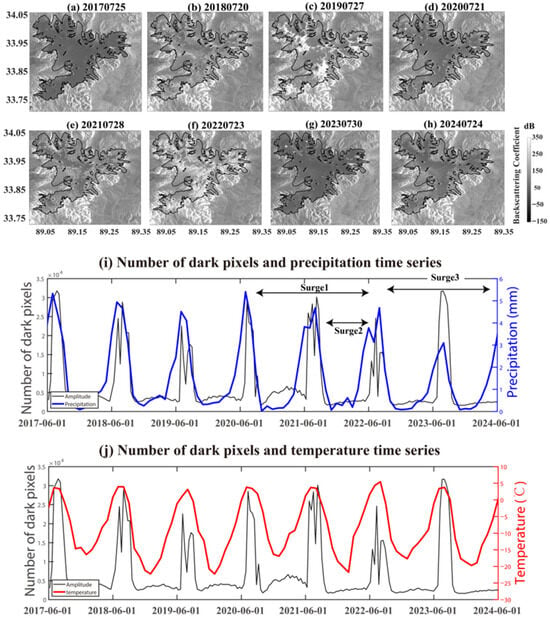
Figure 9.
Time series of radar backscatter-coefficient maps. (a–h) Backscatter-coefficient maps at each end of July from 2017 to 2024, when their values are lowest. (i,j) The number of dark pixels (smaller than the averaged values from the entire image), along with temperature and precipitation records. Surges 1 to 3 indicate the spanning period of the discovered surges on glaciers B0018, B0005, and B0023, respectively.
To quantify the area of surface water, we account for the number of pixels within the PIF with backscattering coefficients smaller than the average values of the entire image for each acquisition and plot them with precipitation (Figure 9i) and temperature (Figure 9j). This plot clearly indicates that the number of dark pixels is significantly larger in summer, when the temperature is higher (resulting in more meltwater) and the precipitation is greater.
Interestingly, we find that the number of dark pixels is the highest in the summer of 2023, suggesting that a significant amount of water was maintained on the surface. However, the precipitation data reveal that 2023 experienced notably less precipitation and slightly lower temperatures than other years. Therefore, the large amount of surface water is a clear sign of a poor drainage system rather than high temperature or more precipitation in the PIF [80].
Zooming in on the three glaciers with surging behavior provides more evidence of their poor drainage systems (Figure 10). We find that since 2020, the backscattering coefficients on the surging glaciers have remained consistently low. We speculate that the drainage system of these glaciers may be destroyed, which caused the accumulation of water on the surface of the glacier before their surges [81,82].
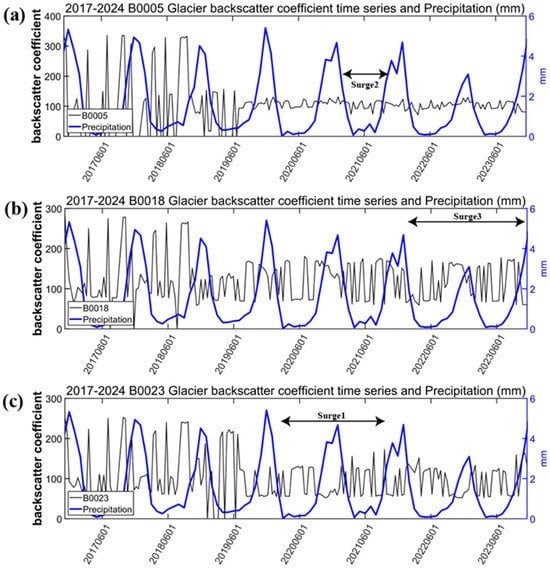
Figure 10.
Time series of backscattering coefficients and precipitations for three surged glaciers: (a) B0005. (b) B0018. (c) B0023.
5. Discussion
5.1. Comprehensive Time-Series Displacements from Radar Imaging Geodesy
Previous studies have provided valuable insights regarding the mass balance and surface velocities on the PIF. Specifically, DEM differencing reveals long-term vertical deformation, primarily indicating changes in mass balance [35,37,39,40,41]. Short-term InSAR and on-site measurements around the 2000s reveal velocities of particular glacier tongues [33,42,43]. Recently, the optical imagery identified several glacier surges from the large displacements and tongue advances on the PIF [44]. However, due to the cloud coverage, capturing the comprehensive velocity field spanning the full surging phase is very challenging. The time-series velocities from radar imaging geodesy capture unprecedented details of the glacier dynamics on the PIF in both space and time.
Comparing with DEM differencing, the elevation changes between 2000 and 2012 [40] and between 2012 and 2016 [35] both indicate that glacier A0008 exhibited strong ablation. This is highly consistent with the fastest flow velocity in winter of glacier A0008, as shown in our InSAR results (Figure 3). This implies that the slow deformation in winter represents the persistent, long-term deformation of the glacier A0008. However, such deformation is too small to be captured by pixel offset tracking. While the glaciers B0023 and B0018 showed higher velocities in the offset results (Figure 4 and Figure 5), indicating that these ice tongues are moving rapidly while melting. The elevation changes also show that the B0018 and B0023 experienced high melting rates between 1975 and 2021 [35,37,39,40].
Comparing with InSAR measurements from the 2000s [33,43], we find that the distribution pattern of glacier velocity has changed. Previous studies show that the A0008 ice tongue moved very slowly, but our results show that the A0008 glacier has been an active one in winter (Figure 3). Interferograms shown in ref. [43] indicate that the movements were mainly concentrated on the three ice tongues in the northeast. However, at present, these glaciers show less obvious movement either in our InSAR or pixel offset results.
Comparing with the recent optical imagery [44], we find that the detection and occurrence time of the surge show a good consistency with our results, although the velocities derived from optical imagery are larger than ours. For example, their study observed maximum surge velocities of 18.7 m/d, 17.09 m/d, and 3.09 m/d for glaciers B0023, B0018, and B0005 during their surge phases, respectively, while our measurements recorded maximum velocities of 8.05 m/d (B0023), 9.26 m/d (B0018), and 2.22 m/d (B0005) during the surge periods (Figure 8d). This difference may be attributed to the more complete and higher temporal resolution Sentinel-1 images that also include the initiation and termination phases of glacier surges, but the velocity from optical imagery may only represent the rapidly moving phases.
5.2. A Possible Mechanism for the Surges on the PIF
Our time-series velocities from radar imaging geodesy clearly reveal the occurrence and extent of surges on three glaciers of the relatively stable and flat PIF. Two main mechanisms have been proposed to explain glacier surging [82]. One is thermal control, resulting in relatively slow, unseasonally sliding that continued for several years; the other is hydrological control, resulting in winter initiation and summer termination.
The absence of thermal control in PIF surges can be explained by contrasting key characteristics. Thermally controlled surges, typically observed in regions such as Svalbard, are characterized by three distinctive features: (1) gradual surge initiation, (2) non-seasonal sliding patterns, and (3) multi-year duration. The thermal-control surges are triggered and propagated through the slow evolution of basal thermal conditions, involving extended precursor periods and slow propagation rates [83].
In contrast, the surge behavior observed in the PIF demonstrates fundamentally different characteristics: (1) abrupt initiation, (2) distinct seasonality with initiation only in early winter, and (3) short duration, typically lasting 1–2 years, and return to normal quickly. The rapid attainment of maximum velocities during early winter in the PIF is completely different from the slow progression expected in thermally controlled surges. The determined temporal behaviors of the three surged glaciers exhibit clear evidence of hydrological control, because their initiation phases are in early winter, and they rapidly reached maximum velocities when other glaciers are quiet.
Based on our observations of surface displacement and backscattering coefficients, we therefore propose a hydrologically driven mechanism to explain the glacier surging on the PIF (Figure 11). Under normal circumstances, the PIF is in a healthy state with drainage systems associated with glaciers. The precipitation and meltwater on the surface can be efficiently discharged to the glacier bed through good drainage channels, e.g., crevasses, resulting in less remaining water on the surface, showing higher radar backscattering coefficients. However, if the drainage system is destroyed, the surface water accumulated in summer cannot be discharged efficiently, forming glacial lakes on the surface, reflected by lower radar backscattering coefficients. When the subglacial water is maintained and probably frozen in the following winter, the pressure of the subglacial drainage system increases, and the effective normal stress decreases, facilitating basal sliding and glacier surging [49]. Here, the role of the undrained water is like a hydraulic jack, lifting the glacier out of the glacier bed [84]. When the surge ends, it is usually accompanied by the sudden release of a large amount of accumulated water, resulting in glacial natural hazards such as floods and glacier lake outbursts. The drainage system may achieve reestablishment after a certain period. Then the glacier returns to its healthy state, where water can be normally discharged from the crevasses, forming a complete cycle (Figure 11).
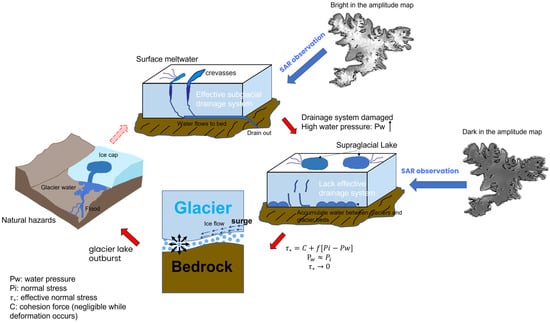
Figure 11.
Conceptual framework illustrating the causes of glacier surging in the PIF.
5.3. Implications of Monitoring Surface Velocity and Backscattering Coefficients from Radar Imagery for Glaciers in High Mountain Asia
It is well accepted that supercontinental glaciers exhibit little seasonal variation [80,85,86,87]. However, through our observations, the seasonal variation in the PIF, a typical supercontinental ice field, is actually greater than we thought. By analyzing their seasonal velocity (Figure 7), we can see that all the glaciers move much faster in summer than in winter. This seasonal variation can even be greater than that of marine glaciers [88]. For instance, the PIF Glacier exhibits considerable seasonal velocity variability, with peak summer velocities reaching 8.37 m/day—approximately 6 times the winter baseline of 1.34 m/day (Figure 8d), and maximum averaged velocity (1.52 m/day) reaches 11 times its averaged winter background (0.13 m/day). In contrast, maritime glaciers in southeastern Tibet demonstrate more moderate seasonal fluctuations: Parlung No. 4 Glacier shows only a 1.4-fold increase in summer velocity (0.18 m/day) compared to winter (0.13 m/day) [89], while Yalong Glacier’s maximum summer speed (0.84 m/day) is just 1.5 times its winter baseline (0.56 m/day) [90]. For the KNS1 (Kangiata Nunata Sermia 1) Glacier in southwestern Greenland, the maximum summer velocity is also only 1.4 times the winter background velocity during summer acceleration [91]. The summer velocity of Hubbard Glacier in southern Alaska (11.5 m/day) is about 1.7 times its winter velocity (6.7 m/day) [92,93]. Our results reveal that the seasonal dynamics of a prototype supercontinent-type icefield, such as the PIF, located in the interior of the Tibetan Plateau, can also be complicated.
For the surging velocity, glaciers in high-latitude regions like Svalbard [94] and Iceland [95] can advance several thousand meters or even tens of thousands of meters in one year. This is 1–2 orders higher than what we observed on the PIF. While the surge on the PIF is comparable to that in Greenland [96,97], where the glacier surges exhibit a similar velocity (2.4~3 m/day) to the PIF (2.22 m/day). Which might be because they both belong to flat-type ice fields, reflecting similarity in ice field dynamics.
Small glaciers on the Tibetan Plateau, such as those in the Geladandong region in the northeast, exhibit surges with velocities of 30~100 m/year [3]. Glaciers in the West Kunlun area, located in the northwest, exhibit a surge velocity of 200–1000 m/year [98]. The Zangser Kangri area, which is also located in the central part of the Tibetan Plateau, recorded a peak surge velocity of 585.77 m/year [99]. The peak surge velocities of the PIF were 211.7 m/year (B0005), 569.4 m/year (B0023), and 810.2 m/year (B0018). These values indicate that the surge velocities in the PIF are generally higher than those in the Geladandong area, lower than those of major surging glaciers in the West Kunlun Mountains, and comparable to the surge velocities observed in the Zangser Kangri area, which is also in the middle of the Tibetan Plateau, reflecting regional similarity.
5.4. Prospects and Limitations
The use of synthetic aperture radar (SAR) imaging geodesy has proven to be an effective method for monitoring glacier dynamics in High Mountain Asia. The proposed methodological framework significantly enhances our understanding of glacier behavior. Specifically, it provides a robust result of long-term, continuous 3D glacier velocity time series and detects the surface water changes in the glacier through backscattering coefficient images. Offset tracking enables 3D glacier velocity and time series measurements, while the SAR backscattering coefficient offers insights into surface water distribution, indicating the subglacial drainage system conditions. This methodological framework holds great potential for early warning systems for glacier surges, ice avalanches, and GLOFs, enabling the development of protection strategies.
At present, the spatial resolution of Sentinel-1 data is 20 m by 5 m. The azimuth spatial resolution reduces the quality of our 3D deformation decomposition. The accuracy of the 3D deformation we obtain, mainly the NS deformation, is not high enough, which hinders further understanding of glacial behavior. The NISAR satellite has now been launched, offering a higher spatial resolution of 3–7 m for its single-look complex (SLC) data with possible interferometry with L-band data. It is anticipated that these upcoming datasets will effectively address the current limitation.
6. Conclusions
This study employs radar imaging geodesy to conduct a comprehensive analysis of the glacier velocity and surge of the PIF. Using InSAR and pixel offset tracking techniques, we obtain high spatiotemporal resolution velocity fields of the PIF over the period from 2017 to 2024. We reveal large seasonal variations and identify surges on three glaciers, reaching 110 m in 12 days, almost tenfold of their normal velocity. These results indicate that the PIF, as a large continental-type glacier, exhibits strong dynamic changes under the background of climate change. We propose that the hydrological control is the main mechanism of the observed surges based on surface displacement and backscattering coefficients from SAR imagery. This study provides a new perspective for understanding the glacier movement in the central Tibetan Plateau and offers important scientific evidence for providing early warning of related disasters. The proposed processing framework can be further applied to other similar glaciers in High Mountain Asia. The recently launched L-band SAR satellites can also improve the resolution and accuracy of the 3D time series for understanding glacier dynamics.
Author Contributions
Conceptualization, T.W.; Methodology, Q.W.; Experimental work and data processing, Q.W.; Data analysis, Q.W.; Validation, Q.W.; Investigation, Q.W.; Writing—original draft preparation, Q.W.; Writing—review and editing, T.W.; Supervision, T.W.; Funding acquisition, T.W. All authors have read and agreed to the published version of the manuscript.
Funding
This work is supported by the National Natural Science Foundation of China (42374019).
Data Availability Statement
The original contributions presented in this study are included in the article. Further inquiries can be directed to the corresponding author.
Conflicts of Interest
The authors declare no conflicts of interest.
Abbreviations
The following abbreviations are used in this manuscript:
| PIF | Puruogangri Ice Field |
| SAR | Synthetic Aperture Radar |
| DEM | Digital Elevation Model |
References
- Xu, J.; Shangguan, D.; Wang, J. Recent surging event of a glacier on Geladandong Peak on the Central Tibetan Plateau. J. Glaciol. 2021, 67, 967–973. [Google Scholar] [CrossRef]
- Fu, X.; Li, Z.; Zhou, J. Characterizing the surge behavior of Alakesayi Glacier in the West Kunlun Shan, Northwestern Tibetan Plateau, from remote-sensing data between 2013 and 2018. J. Glaciol. 2019, 65, 168–172. [Google Scholar] [CrossRef]
- Gao, Y.; Liu, S.; Qi, M.; Zhu, Y.; Xie, F.; Wu, K.; Jiang, Z. Characterizing the behaviour of surge-type glaciers in the Geladandong Mountain Region, Inner Tibetan Plateau, from 1986 to 2020. Geomorphology 2021, 389, 107806. [Google Scholar] [CrossRef]
- Pan, B.; Guan, W.; Shi, M.; Wu, G.; Cheng, J.; Shangguan, D.; Guo, W.; Cao, B. Different characteristics of two surges in Weigeledangxiong Glacier, northeastern Tibetan Plateau. Environ. Res. Lett. 2022, 17, 114009. [Google Scholar] [CrossRef]
- Kääb, A.; Leinss, S.; Gilbert, A.; Bühler, Y.; Gascoin, S.; Evans, S.G.; Bartelt, P.; Berthier, E.; Brun, F.; Chao, W.-A.; et al. Massive collapse of two glaciers in western Tibet in 2016 after surge-like instability. Nat. Geosci. 2018, 11, 114–120. [Google Scholar] [CrossRef]
- Yao, X.; Iqbal, J.; Li, L.J.; Zhou, Z.K. Characteristics of mountain glacier surge hazard: Learning from a surge event in NE Pamir, China. J. Mt. Sci. 2019, 16, 1515–1533. [Google Scholar] [CrossRef]
- Leclercq, P.W.; Kääb, A.; Altena, B. Brief communication: Detection of glacier surge activity using cloud computing of Sentinel-1 radar data. Cryosphere 2021, 15, 4901–4907. [Google Scholar] [CrossRef]
- Li, G.; Chen, Z.; Mao, Y.; Yang, Z.; Chen, X.; Cheng, X. Different glacier surge patterns revealed by Sentinel-2 imagery derived quasi-monthly flow velocity at west Kunlun Shan, Karakoram, Hindu Kush and Pamir. Remote Sens. Environ. 2024, 311, 114298. [Google Scholar] [CrossRef]
- Leprince, S.; Barbot, S.; Ayoub, F.; Avouac, J.P. Automatic and precise orthorectification, coregistration, and subpixel correlation of satellite images, application to ground deformation measurements. IEEE Trans. Geosci. Remote Sens. 2007, 45, 1529–1558. [Google Scholar] [CrossRef]
- Foga, S.; Scaramuzza, P.L.; Guo, S.; Zhu, Z.; Dilley, R.D.; Beckmann, T.; Schmidt, G.L.; Dwyer, J.L.; Joseph Hughes, M.; Laue, B. Cloud detection algorithm comparison and validation for operational Landsat data products. Remote Sens. Environ. 2017, 194, 379–390. [Google Scholar] [CrossRef]
- Zhou, Y.; Li, Z.; Li, J.; Zhao, R.; Ding, X. Glacier mass balance in the Qinghai–Tibet Plateau and its surroundings from the mid-1970s to 2000 based on Hexagon KH-9 and SRTM DEMs. Remote Sens. Environ. 2018, 210, 96–112. [Google Scholar] [CrossRef]
- Mohr, J.J.; Reeh, N.; Madsen, S.N. Three-dimensional glacial flow and surface elevation measured with radar interferometry. Nature 1998, 391, 273–276. [Google Scholar] [CrossRef]
- Joughin, I.R.; Kwok, R.; Fahnestock, M.A. Interferometric estimation of three-dimensional ice-flow using ascending and descending passes. IEEE Trans. Geosci. Remote Sens. 2002, 36, 25–37. [Google Scholar] [CrossRef]
- Sánchez-Gámez, P.; Navarro, F.J. Glacier surface velocity retrieval using D-InSAR and offset tracking techniques applied to ascending and descending passes of Sentinel-1 data for Southern Ellesmere ice caps, Canadian Arctic. Remote Sens. 2017, 9, 442. [Google Scholar] [CrossRef]
- Wang, X.; Yao, J.; Cao, Y.; Yao, J. The improved SBAS-InSAR technique reveals three-dimensional glacier collapse: A case study in the Qinghai–Tibet Plateau. Land 2024, 13, 1126. [Google Scholar] [CrossRef]
- Strozzi, T.; Luckman, A.; Murray, T.; Wegmuller, U.; Werner, C.L. Glacier motion estimation using SAR offset-tracking procedures. IEEE Trans. Geosci. Remote Sens. 2002, 40, 2384–2391. [Google Scholar] [CrossRef]
- Nagler, T.; Rott, H.; Hetzenecker, M.; Wuite, J.; Potin, P. The Sentinel-1 mission: New opportunities for ice sheet observations. Remote Sens. 2015, 7, 9371–9389. [Google Scholar] [CrossRef]
- Wang, Q.; Fan, J.; Zhou, W.; Tong, L.; Guo, Z.; Liu, G.; Yuan, W.; Sousa, J.J.; Perski, Z. 3D Surface velocity retrieval of mountain glacier using an offset tracking technique applied to ascending and descending SAR constellation data: A case study of the Yiga Glacier. Int. J. Digit. Earth 2019, 12, 614–624. [Google Scholar] [CrossRef]
- Hu, J.; Li, Z.-W.; Li, J.; Zhang, L.; Ding, X.-L.; Zhu, J.-J.; Sun, Q. 3-D movement mapping of the alpine glacier in Qinghai-Tibetan Plateau by integrating D-InSAR, MAI and Offset-Tracking: Case study of the Dongkemadi Glacier. Glob. Planet. Change 2014, 118, 62–68. [Google Scholar] [CrossRef]
- Rounce, D.R.; Hock, R.; Maussion, F.; Hugonnet, R.; Kochtitzky, W.; Huss, M.; Berthier, E.; Brinkerhoff, D.; Compagno, L.; Copland, L.; et al. Global glacier change in the 21st century: Every increase in temperature matters. Science 2023, 379, 78–83. [Google Scholar] [CrossRef]
- Xu, B.; Cao, J.; Hansen, J.; Yao, T.; Joswia, D.R.; Wang, N.; Wu, G.; Wang, M.; Zhao, H.; Yang, W.; et al. Black soot and the survival of Tibetan glaciers. Proc. Natl. Acad. Sci. USA 2009, 106, 22114–22118. [Google Scholar] [CrossRef]
- Yao, T.; Thompson, L.; Yang, W.; Yu, W.; Gao, Y.; Guo, X.; Yang, X.; Duan, K.; Zhao, H.; Xu, B.; et al. Different glacier status with atmospheric circulations in Tibetan Plateau and surroundings. Nat. Clim. Change 2012, 2, 663–667. [Google Scholar] [CrossRef]
- Bolch, T.; Kulkarni, A.; Kääb, A.; Huggel, C.; Paul, F.; Cogley, J.G.; Frey, H.; Kargel, J.S.; Fujita, K.; Scheel, M.; et al. The state and fate of Himalayan glaciers. Science 2012, 336, 310–314. [Google Scholar] [CrossRef] [PubMed]
- Guo, W.; Liu, S.; Wei, J.; Bao, W. The 2008/09 surge of central Yulinchuan glacier, northern Tibetan Plateau, as monitored by remote sensing. Ann. Glaciol. 2013, 54, 299–310. [Google Scholar] [CrossRef]
- Guan, W.; Cao, B.; Pan, B.; Chen, R.; Shi, M.; Li, K.; Zhao, X.; Sun, X. Updated surge-type glacier inventory in the West Kunlun Mountains, Tibetan Plateau, and implications for glacier change. J. Geophys. Res. Earth Surf. 2022, 127, e2021JF006369. [Google Scholar] [CrossRef]
- Zhang, Z.; Wang, N.; Wu, Y.; Zhou, S.; Qin, G. Annual and seasonal variations in glacier velocity, and surging glaciers in the West Kunlun Mountain. IEEE J. Sel. Top. Appl. Earth Obs. Remote Sens. 2024, 17, 10703–10714. [Google Scholar] [CrossRef]
- Yang, W.; Guo, X.; Yao, T.; Zhu, M.; Wang, Y. Recent accelerating mass loss of southeast Tibetan glaciers and the relationship with changes in macroscale atmospheric circulations. Clim. Dyn. 2016, 47, 805–815. [Google Scholar] [CrossRef]
- Kapnick, S.B.; Delworth, T.L.; Ashfaq, M.; Malyshev, S.; Milly, P.C.D. Snowfall less sensitive to warming in Karakoram than in Himalayas due to a unique seasonal cycle. Nat. Geosci. 2014, 7, 834–840. [Google Scholar] [CrossRef]
- Gardelle, J.; Berthier, E.; Arnaud, Y. Slight mass gain of Karakoram glaciers in the early twenty-first century. Nat. Geosci. 2012, 5, 322–325. [Google Scholar] [CrossRef]
- Farinotti, D.; Immerzeel, W.W.; de Kok, R.J.; Quincey, D.J.; Dehecq, A. Manifestations and mechanisms of the Karakoram glacier Anomaly. Nat. Geosci. 2020, 13, 8–16. [Google Scholar] [CrossRef]
- Yi, C.L.; Li, X.Z.; Qu, J.J. Quaternary glaciation of Puruogangri—The largest modern ice field in Tibet. Quat. Int. 2002, 97–98, 111–121. [Google Scholar] [CrossRef]
- Pu, J.C.; Yao, T.D.; Wang, N.L.; Ding, L.F.; Zhang, Q.H. Puruogangri Ice Filed and its variation since the Little Ice Age of the northern Tibetan Plateau. J. Glaciol. Geocryol. 2002, 24, 87–92. [Google Scholar]
- Huintjes, E.; Neckel, N.; Hochschild, V.; Schneider, C. Surface energy and mass balance at Purogangri ice cap, central Tibetan Plateau, 2001–2011. J. Glaciol. 2015, 61, 1048–1060. [Google Scholar] [CrossRef]
- Jiao, K.Q.; Zhang, Z.S. Glacier Inventory of China VII: Qinghai-Xizang Plateau Interior Area (Drainage Basins of the Seling Lake); Science Press: Beijing, China, 1988. [Google Scholar]
- Liu, L.; Jiang, L.; Sun, Y.; Yi, C.; Wang, H.; Hsu, H. Glacier elevation changes (2012–2016) of the Puruogangri Ice Field on the Tibetan Plateau derived from bi-temporal TanDEM-X InSAR data. Int. J. Remote Sens. 2016, 37, 5687–5707. [Google Scholar] [CrossRef]
- Yao, T.D. Puruogangri ice field was discovered in middle of Tibetan Plateau. J. Glaciol. Geocryol. 2000, 22, 1–2. [Google Scholar]
- Ren, S.; Li, X.; Wang, Y.; Zheng, D.; Jiang, D.; Nian, Y.; Zhou, Y. Multitemporal glacier mass balance and area changes in the Puruogangri Ice Field during 1975–2021 based on multisource satellite observations. Remote Sens. 2022, 14, 4078. [Google Scholar] [CrossRef]
- Raup, B.; Kääb, A.; Kargel, J.S.; Bishop, M.P.; Hamilton, G.; Lee, E.; Paul, F.; Rau, F.; Soltesz, D.; Khalsa, S.J.S. Remote sensing and GIS technology in the Global Land Ice Measurements from Space (GLIMS) project. Comput. Geosci. 2007, 33, 104–125. [Google Scholar] [CrossRef]
- Liu, L.; Jiang, L.; Sun, Y.; Wang, H.; Yi, C.; Hsu, H. Morphometric controls on glacier mass balance of the puruogangri ice field, central tibetan plateau. Water 2016, 8, 496. [Google Scholar] [CrossRef]
- Neckel, N.; Braun, A.; Kropáček, J.; Hochschild, V. Recent mass balance of the Purogangri Ice Cap, central Tibetan Plateau, by means of differential X-band SAR interferometry. Cryosphere 2013, 7, 1623–1633. [Google Scholar] [CrossRef]
- Liu, L.; Jiang, L.M.; Jiang, H.J.; Wang, H.S.; Ma, N.; Xu, H.Z. Accelerated glacier mass loss (2011–2016) over the Puruogangri ice field in the inner Tibetan Plateau revealed by bistatic InSAR measurements. Remote Sens. Environ. 2019, 231, 111241. [Google Scholar] [CrossRef]
- Jin, Z.F.; Yao, T.D.; Wang, N.L. The surface flow features of the Puruogangri ice field. J. Glaciol. Geocryol. 2003, 25, 288–290. [Google Scholar]
- Liu, L.; Jiang, L.; Wang, H. Extraction of glacier surface elevation and velocity in high Asia with ERS-1/2 Tandem SAR data: Application to Puruogangri ice field, Tibetan Plateau. In Proceedings of the 2012 IEEE International Geoscience and Remote Sensing Symposium, Munich, Germany, 22–27 July 2012; pp. 4442–4445. [Google Scholar]
- Zhou, S.; Wang, N.; Li, Z.; Yao, X.; Zhang, Y.; Qin, G. Characterizing the behavior of surge-type glaciers in the Puruogangri Ice Field, Tibetan Plateau. J. Geogr. Sci. 2024, 34, 1174–1194. [Google Scholar] [CrossRef]
- Yao, X.; Zhou, S.; Sun, M.; Duan, H.; Zhang, Y. Surging Glaciers in High Mountain Asia between 1986 and 2021. Remote Sens. 2023, 15, 4595. [Google Scholar] [CrossRef]
- Zhang, W. Identification of glaciers with surge characteristics on the Tibetan Plateau. Ann. Glaciol. 1992, 16, 168–172. [Google Scholar][Green Version]
- Kamb, B.; Engelhardt, H. Waves of accelerated motion in a glacier approaching surge: The mini-surges of Variegated Glacier, Alaska, USA. J. Glaciol. 1987, 33, 27–46. [Google Scholar] [CrossRef]
- Eisen, O.; Harrison, W.D.; Raymond, C.F.; Echelmeyer, K.A.; Bender, G.A.; Gorda, J.L. Variegated Glacier, Alaska, USA: A century of surges. J. Glaciol. 2005, 51, 399–406. [Google Scholar] [CrossRef]
- Kamb, B.; Raymond, C.; Harrison, W.; Engelhardt, H.; Echelmeyer, K.; Humphrey, N.; Brugman, M.; Pfeffer, T. Glacier surge mechanism: 1982–1983 surge of Variegated Glacier, Alaska. Science 1985, 227, 469–479. [Google Scholar] [CrossRef]
- Burgess, E.W.; Forster, R.R.; Larsen, C.F.; Braun, M. Surge dynamics on Bering Glacier, Alaska, in 2008–2011. Cryosphere 2012, 6, 1251–1262. [Google Scholar] [CrossRef]
- Paul, F.; Strozzi, T.; Schellenberger, T.; Kääb, A. The 2015 surge of Hispar Glacier in the Karakoram. Remote Sens. 2017, 9, 888. [Google Scholar] [CrossRef]
- Quincey, D.J.; Glasser, N.F.; Cook, S.J.; Luckman, A. Heterogeneity in Karakoram glacier surges. J. Geophys. Res. Earth Surf. 2015, 120, 1288–1300. [Google Scholar] [CrossRef]
- Hewitt, K. Tributary glacier surges: An exceptional concentration at Panmah Glacier, Karakoram Himalaya. J. Glaciol. 2007, 53, 181–188. [Google Scholar] [CrossRef]
- Rashid, I.; Abdullah, T.; Glasser, N.F.; Naz, H.; Romshoo, S.A. Surge of Hispar Glacier, Pakistan, between 2013 and 2017 detected from remote sensing observations. Geomorphology 2018, 303, 410–416. [Google Scholar] [CrossRef]
- Hersbach, H.; Bell, B.; Berrisford, P.; Hirahara, S.; Horányi, A.; Muñoz-Sabater, J.; Nicolas, J.; Peubey, C.; Radu, R.; Schepers, D.; et al. The ERA5 global reanalysis. Q. J. R. Meteorol. Soc. 2020, 146, 1999–2049. [Google Scholar] [CrossRef]
- Chen, C.W.; Zebker, H.A. Network approaches to two-dimensional phase unwrapping: Intractability and two new algorithms. J. Opt. Soc. Am. A 2000, 17, 401–414. [Google Scholar] [CrossRef] [PubMed]
- Chen, Q.; Luo, R.; Yang, Y.; Yong, Q. Method and accuracy of extracting surface deformation field from SAR image coregistration. Acta Geod. Et Cartogr. Sin. 2015, 44, 301–308. [Google Scholar]
- Gomez, R.; Arigony-Neto, J.; De Santis, A.; Vijay, S.; Jana, R.; Rivera, A. Ice dynamics of union glacier from SAR offset tracking. Glob. Planet. Change 2019, 174, 1–15. [Google Scholar] [CrossRef]
- Wang, W.; Liu, Y.H.; Fan, X.R.; Ma, C.; Shan, X.J. Coseismic deformation, fault slip distribution, and Coulomb stress perturbation of the 2023 Türkiye-Syria earthquake doublet based on SAR offset tracking. Remote Sens. 2023, 15, 5443. [Google Scholar] [CrossRef]
- Wen, M.; Wang, T. Review of SAR imaging geodesy for glacier velocity monitoring. Geod. Geodyn. 2024, 16, 262–274. [Google Scholar] [CrossRef]
- Scherler, D.; Leprince, S.; Strecker, M.R. Glacier-surface velocities in alpine terrain from optical satellite imagery—Accuracy improvement and quality assessment. Remote Sens. Environ. 2008, 112, 3806–3819. [Google Scholar] [CrossRef]
- Scambos, T.A.; Dutkiewicz, M.J.; Wilson, J.C.; Bindschadler, R.A. Application of image cross-correlation to the measurement of glacier velocity using satellite image data. Remote Sens. Environ. 1992, 42, 177–186. [Google Scholar] [CrossRef]
- Heid, T.; Kääb, A. Evaluation of existing image matching methods for deriving glacier surface displacements globally from optical satellite imagery. Remote Sens. Environ. 2012, 118, 339–355. [Google Scholar] [CrossRef]
- Fahnestock, M.; Scambos, T.; Moon, T.; Gardner, A.; Haran, T.; Klinger, M. Rapid large-area mapping of ice flow using Landsat 8. Remote Sens. Environ. 2016, 185, 84–94. [Google Scholar] [CrossRef]
- Debella-Gilo, M.; Kääb, A. Sub-pixel precision image matching for measuring surface displacements on mass movements using normalized cross-correlation. Remote Sens. Environ. 2011, 115, 130–142. [Google Scholar] [CrossRef]
- Hanssen, R.F. Radar Interferometry Data Interpretation and Error Analysis; Springer: Berlin/Heidelberg, Germany, 2001. [Google Scholar]
- Wang, T.; Jónsson, S. Improved SAR amplitude image offset measurements for deriving three-dimensional coseismic displacements. IEEE J. Sel. Top. Appl. Earth Obs. Remote Sens. 2015, 8, 3271–3278. [Google Scholar] [CrossRef]
- Wang, Y.; Zhao, J.; Li, Z.; Zhang, M.; Wang, Y.; Liu, J.; Yang, J.; Yang, Z. Retrieving and verifying three-dimensional surface motion displacement of mountain glacier from Sentinel-1 imagery using optimized method. Water 2021, 13, 1793. [Google Scholar] [CrossRef]
- Berardino, P.; Fornaro, G.; Lanari, R.; Sansosti, E. A new algorithm for surface deformation monitoring based on small baseline differential SAR interferograms. IEEE Trans. Geosci. Remote Sens. 2002, 40, 2375–2383. [Google Scholar] [CrossRef]
- Lanari, R.; Mora, O.; Manunta, M.; Mallorqui, J.J.; Berardino, P.; Sansosti, E. A small-baseline approach for investigating deformations on full-resolution differential SAR interferograms. IEEE Trans. Geosci. Remote Sens. 2004, 42, 1377–1386. [Google Scholar] [CrossRef]
- Yang, L.; Zhao, C.; Lu, Z.; Yang, C.; Zhang, Q. Three-dimensional time series movement of the Cuolangma glaciers, southern Tibet with Sentinel-1 imagery. Remote Sens. 2020, 12, 3466. [Google Scholar] [CrossRef]
- Casu, F.; Manconi, A.; Pepe, A.; Lanari, R. Deformation time-series generation in areas characterized by large displacement dynamics: The SAR amplitude pixel-offset SBAS technique. IEEE Trans. Geosci. Remote Sens. 2011, 49, 2752–2763. [Google Scholar] [CrossRef]
- Zou, A.J. Research on Coseismic Deformation Monitoring Based on Image Correlation Technology. Master’s Thesis, East China University of Technology, Nanchang, China, 2022. [Google Scholar]
- Wang, T.; Wei, S.; Shi, X.; Qiu, Q.; Li, L.; Peng, D.; Weldon, R.J.; Barbot, S. The 2016 Kaikōura earthquake: Simultaneous rupture of the subduction interface and overlying faults. Earth Planet. Sci. Lett. 2018, 482, 44–51. [Google Scholar] [CrossRef]
- Morishita, Y.; Kobayashi, T.; Fujiwara, S.; Yarai, H. Complex crustal deformation of the 2016 Kaikoura, New Zealand, earthquake revealed by ALOS-2. Bull. Seismol. Soc. Am. 2017, 107, 2676–2686. [Google Scholar] [CrossRef]
- Li, J.; Li, Z.-W.; Wu, L.-X.; Xu, B.; Hu, J.; Zhou, Y.-S.; Miao, Z.-L. Deriving a time series of 3D glacier motion to investigate interactions of a large mountain glacial system with its glacial lake: Use of Synthetic Aperture Radar Pixel Offset-Small Baseline Subset technique. J. Hydrol. 2018, 559, 596–608. [Google Scholar] [CrossRef]
- Bartholomaus, T.C.; Anderson, R.S.; Anderson, S.P. Response of glacier basal motion to transient water storage. Nat. Geosci. 2008, 1, 33–37. [Google Scholar] [CrossRef]
- Sugiyama, S.; Skvarca, P.; Naito, N.; Enomoto, H.; Tsutaki, S.; Tone, K.; Marinsek, S.; Aniya, M. Ice speed of a calving glacier modulated by small fluctuations in basal water pressure. Nat. Geosci. 2011, 4, 597–600. [Google Scholar] [CrossRef]
- Millan, R.; Mouginot, J.; Rabatel, A.; Morlighem, M. Ice velocity and thickness of the world’s glaciers. Nat. Geosci. 2022, 15, 124–129. [Google Scholar] [CrossRef]
- Cuffey, K.M.; Paterson, W.S.B. The Physics of Glaciers; Academic Press: Cambridge, MA, USA, 2010. [Google Scholar]
- Paterson, W.S.B.; Andrews, J.T. The Physics of Glaciers. Phys. Today 1982, 35, 59–61. [Google Scholar] [CrossRef]
- Harrison, W.D.; Post, A.S. How much do we really know about glacier surging? Ann. Glaciol. 2003, 36, 1–6. [Google Scholar] [CrossRef]
- Murray, T.; Stuart, G.W.; Miller, P.J.; Woodward, J.; Smith, A.M.; Porter, P.R.; Jiskoot, H. Glacier surge propagation by thermal evolution at the bed. J. Geophys. Res. Solid Earth 2000, 105, 13491–13507. [Google Scholar] [CrossRef]
- Qiu, J. Ice on the run. Science 2017, 358, 1120–1123. [Google Scholar] [CrossRef]
- Huang, M.H.; Sun, Z.Z. Some flow characteristics of continental-type glaciers in China. J. Glaciolgy Geocryol. 1982, 4, 35–45. [Google Scholar]
- Zhang, Y.S.; Yao, T.D.; Pu, J.C. The response of continental type glaciers to climate change in China. J. Glaciolgy Geocryol. 1998, 20, 3–8. [Google Scholar]
- Su, B.; Li, Z.Q.; Zhang, M.J.; Guo, R.; Sun, M.P.; Che, Y.J.; Ying, X. A comparative study on mass balance between the continental glaciers and the temperate glaciers: Taking the typical glaciers in the Tianshan Mountains and the Alps as examples. J. Glaciolgy Geocryol. 2015, 37, 1131–1140. [Google Scholar]
- Li, K.M.; Chen, S.F.; Kang, L.F.; Li, Z.Q.; Li, S.D.; Wen, Q. Variation of continental glacier and temperate glacier in China: A case study of Glacier No.1 at the headwaters of the Urumqi River and Baishui Glacier No.1. Arid Zone Res. 2018, 35, 12–19. [Google Scholar]
- Yang, W.; Zhao, C.; Westoby, M.; Yao, T.; Wang, Y.; Pellicciotti, F.; Zhou, J.; He, Z.; Miles, E. Seasonal dynamics of a temperate Tibetan glacier revealed by high-resolution UAV photogrammetry and in situ measurements. Remote Sens. 2020, 12, 2389. [Google Scholar] [CrossRef]
- Xiong, J.; Fan, X.; Dou, X.; Yang, Y. Seasonal variation of Yalong Glacier’s velocity in Ranwu Lake Basin, southeast Tibetan Plateau. Geomat. Inf. Sci. Wuhan Univ. 2021, 46, 1579–1588. [Google Scholar] [CrossRef]
- Sole, A.J.; Mair, D.W.F.; Nienow, P.W.; Bartholomew, I.D.; King, M.A.; Burke, M.J.; Joughin, I. Seasonal speedup of a Greenland marine-terminating outlset glacier forced by surface melt–induced changes in subglacial hydrology. J. Geophys. Res. Earth Surf. 2011, 116, F03014. [Google Scholar] [CrossRef]
- Rogers, D. The Relationship Between Seasonal Fluctuations in Ice Velocity and Surge-Type Behaviour in Glaciers: Hubbard glacier, Alaska, USA. Ph.D. Thesis, Bournemouth University, Poole, UK, 2023. [Google Scholar]
- Ritchie, J.B.; Lingle, C.S.; Motyka, R.J.; Truffer, M. Seasonal fluctuations in the advance of a tidewater glacier and potential causes: Hubbard Glacier, Alaska, USA. J. Glaciol. 2008, 54, 401–411. [Google Scholar] [CrossRef][Green Version]
- Murray, T.; Luckman, A.; Strozzi, T.; Nuttall, A.-M. The initiation of glacier surging at Fridtjovbreen, Svalbard. Ann. Glaciol. 2003, 36, 110–116. [Google Scholar] [CrossRef]
- Auriac, A.; Sigmundsson, F.; Hooper, A.; Spaans, K.; Björnsson, H.; Pálsson, F.; Pinel, V.; Feigl, K. InSAR observations and models of crustal deformation due to a glacial surge in Iceland. Geophys. J. Int. 2014, 198, 1329–1341. [Google Scholar] [CrossRef]
- Pritchard, H.; Murray, T.; Luckman, A.; Strozzi, T.; Barr, S. Glacier surge dynamics of Sortebræ, east Greenland, from synthetic aperture radar feature tracking. J. Geophys. Res. Earth Surf. 2005, 110, F03005. [Google Scholar] [CrossRef]
- Solgaard, A.; Simonsen, S.; Grinsted, A.; Mottram, R.; Karlsson, N.; Hansen, K.; Kusk, A.; Sørensen, L. Hagen Bræ: A surging glacier in North Greenland—35 years of observations. Geophys. Res. Lett. 2020, 47, e2019GL085802. [Google Scholar] [CrossRef]
- Yasuda, T.; Furuya, M. Dynamics of surge-type glaciers in West Kunlun Shan, Northwestern Tibet. J. Geophys. Res. Earth Surf. 2015, 120, 2393–2405. [Google Scholar] [CrossRef]
- Jia, B.; Hou, S.; Wang, Y. A surging glacier recognized by remote sensing on the Zangser kangri ice field, central Tibetan plateau. Remote Sens. 2021, 13, 1220. [Google Scholar] [CrossRef]
Disclaimer/Publisher’s Note: The statements, opinions and data contained in all publications are solely those of the individual author(s) and contributor(s) and not of MDPI and/or the editor(s). MDPI and/or the editor(s) disclaim responsibility for any injury to people or property resulting from any ideas, methods, instructions or products referred to in the content. |
© 2025 by the authors. Licensee MDPI, Basel, Switzerland. This article is an open access article distributed under the terms and conditions of the Creative Commons Attribution (CC BY) license (https://creativecommons.org/licenses/by/4.0/).